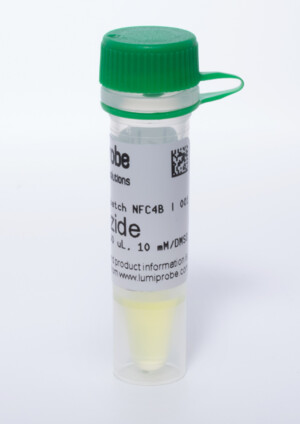FAM azide, 5-isomer
| Cat. # | Quantity | Price | Lead time | Buy this product |
|---|---|---|---|---|
| 14130 | 100 uL, 10 mM/DMSO |
$69
|
in stock | |
| 34130 | 500 uL, 10 mM/DMSO |
$97
|
in stock | |
| 44130 | 1 mL, 10 mM/DMSO |
$139
|
in stock | |
| A4130 | 1 mg |
$69
|
in stock | |
| B4130 | 5 mg |
$97
|
5 days | |
| C4130 | 10 mg |
$139
|
in stock | |
| D4130 | 25 mg |
$285
|
in stock | |
| E4130 | 50 mg |
$445
|
in stock | |
| F4130 | 100 mg |
$765
|
in stock |

FAM azide for сlick chemistry labeling. FAM remains one of the most popular fluorescent labels for various applications. Most instruments capable of fluorescence detection, ranging from plate readers to fluorescence microscopes, are able to work in the FAM channel.
With the versatility of сlick chemistry and this reagent, it is possible to attach this popular fluorophore to nearly any alkyne-bearing molecule.
FAM azide is available both as a solid compound and as a 10 mM solution in DMSO ready to use in our recommended labeling protocol. This product is a pure 5-isomer. FAM is a replacement for DyLight 488.
Absorption and emission spectra of FAM

Customers also purchased with this product
General properties
| Appearance: | yellowish crystals |
| Molecular weight: | 458.42 |
| CAS number: | 510758-23-3 |
| Molecular formula: | C24H18N4O6 |
| Solubility: | soluble in polar organic solvents (DMF, DMSO, alcohols) |
| Quality control: | NMR 1H, HPLC-MS (95%) |
| Storage conditions: | Storage: 24 months after receival at -20°C in the dark. Transportation: at room temperature for up to 3 weeks. Avoid prolonged exposure to light. |
| MSDS: | Download |
| Product specifications |
Spectral properties
| Excitation/absorption maximum, nm: | 492 |
| ε, L⋅mol−1⋅cm−1: | 74000 |
| Emission maximum, nm: | 517 |
| Fluorescence quantum yield: | 0.93 |
| CF260: | 0.22 |
| CF280: | 0.17 |
Product citations
- Ford, A. L.; Taft, C. W.; Sprague-Getsy, A. M.; Carlson, G. C.; Mate, N. A.; Sieburg, M. A.; Chisholm, J. D.; Hougland, J. L. A Modular Customizable Ligand-Conjugate (LC) System Targeting Ghrelin O-Acyltransferase. Biomolecules, 2025, 15(2), 204. doi: 10.3390/biom15020204
- Ho H’ng, C.; Amarasinghe, S.L.; Zhang, B.; Chang, H.; Qu, X.; Powell, D.R.; Rosello-Diez, A. Compensatory growth and recovery of cartilage cytoarchitecture after transient cell death in fetal mouse limbs. Nature Communications, 2024, 15, 2940. doi: 10.1038/s41467-024-47311-7
- Olson, S. W.; Turner, A.-M. W.; Arney, J. W.; Saleem, I.; Weidmann, C. A.; Margolis, D. M.; Weeks, K. M.; Mustoe, A. M. Discovery of a Large-Scale, Cell-State-Responsive Allosteric Switch in the 7SK RNA Using DANCE-MaP. Molecular Cell, 2022, 82(9), 1708-1723.e10. doi: 10.1016/j.molcel.2022.02.009
- Perzanowska, O.; Smietanski, M.; Jemielity, J.; Kowalska, J. Chemically Modified Poly(A) Analogs Targeting PABP: Structure Activity Relationship and Translation Inhibitory Properties. Chemistry – A European Journal, 2022, 28(42), e202201115. doi: 10.1002/chem.202201115



























 $
$ 
